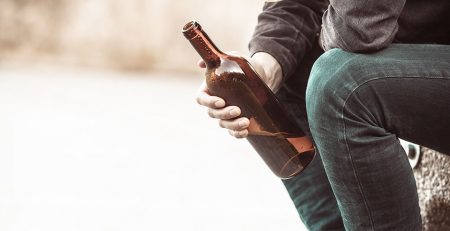Over 14 million adults in the United States have an alcohol use disorder, and the state of Florida is a part of this problem.1 As a luxury drug and alcohol rehab in South Florida, we know that while social drinking is often considered acceptable, the line dividing carefree drinking with friends and an alcohol use disorder is easy to cross without realizing it. Many Floridians and visitors to the Sunshine State are struggling with this line, so we’re sharing more on Florida alcohol abuse and the toll it’s taken.
Florida Alcohol Facts and Statistics
Although Florida has a reputation for being a state filled with retirees, it’s a lot more than just a sleepy retirement community. While many people are quick to point fingers at spring breakers and tourists, there’s a major problem with heavy and chronic drinking in Florida.
From 2009 to 2015, Florida adults had a higher prevalence rate of past 30-day alcohol use than the national average. Also, the number of underage Floridians aged 12 to 17 who had alcohol in the past 30 days was around the same as the national average.2
Although the drinking age in Florida is 21 and older, it didn’t seem to matter to some residents. From 2017 to 2019, the annual average prevalence of past-month alcohol use in Florida in youth aged 12 to 17 was 10% (or 144,000), similar to both the regional average (9.2%) and the national average (9.4%).3
In people aged 12 and older, the annual average prevalence of past-year alcohol use disorder in Florida was 4.2% (or 770,000), similar to the regional average (4.5%) but lower than the national average (5.3%).3 While drinking rates have been declining overall in the past few years, there is still a lot of room for improvement.
There were more than 10,000 people who were admitted to a Florida substance abuse treatment center for alcohol in 2016, but this number has been declining since 2011 at a faster rate than the decline in drinking problems and alcoholism in Florida.4 So while some people are getting help, it isn’t enough.
One 2019 study found that 18% of adults in Florida engaged in heavy drinking or binge drinking, indicating a slight increase from 16.2% in 2002.5 Alcohol is also the most frequently occurring drug among decedents, according to the Florida Medical Examiners Commission.
Alcohol-related deaths also increased across the state from 2012 to 2019, and the number of decedents in which alcohol contributed a causal role in death increased by 72% from 2012 to 2019.5 The total number of alcohol-related occurrences, which is when a substance is present and identifiable in the death, also increased statewide from 4,029 to 5,385 occurrences.5
On top of the Florida drinking problems among residents, the Sunshine State’s tropical climate has also made it both a spring break destination and a year-round vacation spot. A study on people’s social media posts found that in 2018, Miami was the top spring break destination in the United States, and Fort Lauderdale was ranked as the booziest spring break destination.9
Not only are the spring breakers binge drinking in Florida, but other tourists are also flocking to the state, and many may be drinking while they are here. In 2022, Florida had a record number of 137.6 million tourists.7 Even if the family is present, it is not unlike tourists to eat and drink more as they cite the excuse that they are on vacation.
However, Florida alcohol abuse extends beyond just alcohol consumption. Alcohol abuse is often accompanied by poor decisions that can lead to driving while intoxicated and alcohol-related injuries. In 2019, there were a total of 10,142 national alcohol-impaired driving fatalities, 814 of which occurred in Florida. Additionally, of all Florida fatalities, 26% were alcohol-related and occurred in Florida, which was close to the national percentage of 28.1.8
Alcohol-impaired driving fatalities per 100,000 people occurred at a rate of 3.8% in Florida, which was higher than the national average of 3.1%.8 If Florida’s drinking problems continue and people neglect to undergo medical detox or treatment, these deaths could continue to increase.
Call Our Florida Alcohol Rehab Today
Long-term alcohol abuse can lead to a variety of problems, ranging from worsening mental illness to liver disease, skin damage, and more. Alcoholism can also greatly impact a person’s ability to carry out daily functioning, fulfill responsibilities at home or school, and sustain healthy relationships.
Whether you’re an alcoholic or your loved one has a drinking problem, you should get help right away. As a luxury drug and alcohol rehab in Palm Beach, we offer luxury addiction treatment for numerous substance use disorders in a safe, clean, and comfortable environment. We also provide clients with numerous amenities like private living space and transportation to our facility.
Call Seaside Palm Beach today at 561-677-9374 or send us your contact information to learn more about our Florida alcohol detox and alcohol rehab program and how we can help you or a loved one get sober.
Sources:
- NIH – Alcohol Facts and Statistics
- FADAA – Patterns and Trends of Substance Use Within and Across the Regions of Florida April 2019
- SAMHSA – Behavioral Health Barometer
- Florida Health – 2016-2017 Prescription Drug Monitoring Program Annual Report
- CDAC – Alcohol Consumption Trends Across the Nation and Florida
- Medical Examiners Commission – Drugs Identified in Deceased Persons by Florida Medical Examiners
- CBS Miami – Florida tourism hits record number in 2022
- Responsibility – National Drunk Driving Statistics Map
- Patch – Spring Break 2018: Florida Is Most Popular Destination
Related Reading:













